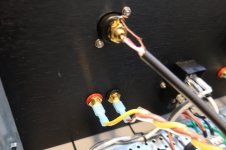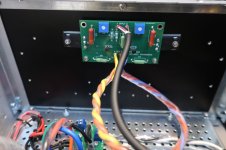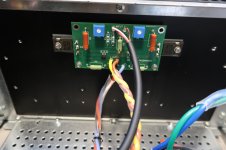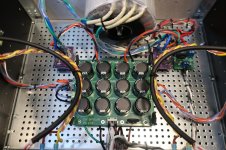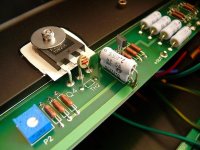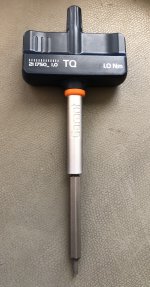- how about a couple of nice clean new power supply threads? Each starting with some schematics and a basic build guide?
- One about the basic Nelson-style linear power supply and its variations.
- One about switching supplies, probably mostly MeanWell.
I don't have the expertise to do this myself, but there are surely quite a few folks here who do.
Are you requesting a gift? Someone please do a favor for me, however I offer nothing in return?
Or maybe you're proposing a trade? A barter? Someone please do ABC for me but only after I do XYZ for them?
It's usually better to explain the benefits when making a request; and how the benefits flow in both directions. Then each party has a solid answer to the question "how would this proposal benefit me?"
Last edited:
I don't want to complain, but isn't this the F5m thread? Not a power supply thread?
This seems to happen over and over in many of the different threads for the different projects - they get hijacked for very similar, quite repetitive minor power supply connection issues.
Where I'm going is:
- how about a couple of nice clean new power supply threads? Each starting with some schematics and a basic build guide?
- One about the basic Nelson-style linear power supply and its variations.
- One about switching supplies, probably mostly MeanWell.
I don't have the expertise to do this myself, but there are surely quite a few folks here who do.
Moderators?
6L6?
Some of the people making these posts have noted the absence of consolidated and comprehensive power supply information in the past. In fact I'm pretty sure I've been a pain in the neck about it. The responses fall into two broad categories:
1) it's too simple to warrant explanation here and curious parties can be self-sufficient and learn about it somewhere else
2) it's a valid point, and we hear you, but everything here is provided by people volunteering their time so it is what it is until someone gets around to it
Accepting the latter and failing to find answers as per the former, here we are.
It's also worth considering that, while you can order the F5M boards without the bipolar supply, the bipolar supply was made specifically for the F5M and is detailed in the F5M document by Nelson. I believe the whole thing was done as a way to simplify this power supply question for people who want to learn. As such, not only is this the one amplifier thread in which power supply hookup questions are most valid, excluding them would seem to go against the spirit of the whole endeavour.
That said, if someone knowledgeable is happy to volunteer time answering many, many stupid questions, I am happy to format, edit, collate and organise their knowledge into a digestible format to help solve this problem.
^ Very well-said.
However, there are two additions I'd offer -
3) The regulations around mains electricity in various parts of the world make it challenging to provide anything that may be "consolidated" nevertheless comprehensive.
4) There are complexities of navigating liability when presenting guidance, however 'official or unofficial' to a world-wide audience of DIYers.

My $0.02 - Ask away.
If those that want a consolidated thread or threads will organize the resources / content / legal code / validation of standards, then I'm sure those efforts will be hugely appreciated by many. There is a whisper of a rumor of a hint of an idea that there will be at least one build guide for at least one 24V bipolar power supply. There could possibly even be two... one linear and one "SMPS-based". No promises.
Mainly, different PSU information applies to different amps. My advice is that if anyone is confused about the PSU for their specific amp, in their specific situation, ask in the appropriate thread. Generalizations may ... not ... be ... good.
Believe me, I don't like "clutter" in threads, but I lean toward making sure everyone is safe.
However, there are two additions I'd offer -
3) The regulations around mains electricity in various parts of the world make it challenging to provide anything that may be "consolidated" nevertheless comprehensive.
4) There are complexities of navigating liability when presenting guidance, however 'official or unofficial' to a world-wide audience of DIYers.

My $0.02 - Ask away.
If those that want a consolidated thread or threads will organize the resources / content / legal code / validation of standards, then I'm sure those efforts will be hugely appreciated by many. There is a whisper of a rumor of a hint of an idea that there will be at least one build guide for at least one 24V bipolar power supply. There could possibly even be two... one linear and one "SMPS-based". No promises.
Mainly, different PSU information applies to different amps. My advice is that if anyone is confused about the PSU for their specific amp, in their specific situation, ask in the appropriate thread. Generalizations may ... not ... be ... good.
Believe me, I don't like "clutter" in threads, but I lean toward making sure everyone is safe.
Thanks to everyone's help, suggestions, and putting up with my sass, I managed to finish my build! It's not perfect, for example, one channel still uses a black wire instead of a brown wire ( chose to leave the black wire for now ), and the black/red wires from the snubber board to the PSU board are swapped; black should go to + instead of -. ( next build, I'll have black as live all the way to the doughnut ) I added blue locktite to the earth ground screws. I also turned the trims counter clockwise when looking at the PCBs with trims at the top. ( what is this 'ticklin' the dragon' I read about? not sure... )
I still need to insert a 2.5A fuse on the PEM live ( hope that is the correct value ) and then test with a DM for shorts and other potential issues.
Thanks again to everyone for the help and Nelson Pass for making this design available. I would not have been able to get this amazing amp otherwise!! ( hope it powers up too )
I still need to insert a 2.5A fuse on the PEM live ( hope that is the correct value ) and then test with a DM for shorts and other potential issues.
Thanks again to everyone for the help and Nelson Pass for making this design available. I would not have been able to get this amazing amp otherwise!! ( hope it powers up too )
Attachments
Last edited:
@Mark Johnson: This is different than telling somebody to buckle down and learn more about the fundamentals of circuit design in response to a question.
I'm not asking for a "gift". I am asking about whether there is some form of organization/leadership within this forum to add a place where the repeated power supply stuff could be found, instead of being randomly distributed over and over again randomly throughout thousands of posts. Folks with power supply issues could then be referred to those threads, or could easily figure out to post there in the first place.
I have no authority to do such a thing. Does anyone? Is this idea of leadership/authority not viable to the forum? If this is so, and anarchy is the only option, so be it. But to characterize raising the question as "asking for a gift" doesn't pass the laugh test and doesn't answer the question.
I'm not asking for a "gift". I am asking about whether there is some form of organization/leadership within this forum to add a place where the repeated power supply stuff could be found, instead of being randomly distributed over and over again randomly throughout thousands of posts. Folks with power supply issues could then be referred to those threads, or could easily figure out to post there in the first place.
I have no authority to do such a thing. Does anyone? Is this idea of leadership/authority not viable to the forum? If this is so, and anarchy is the only option, so be it. But to characterize raising the question as "asking for a gift" doesn't pass the laugh test and doesn't answer the question.
Jim Tieman's (@6L6, I believe) Burning Amp talk this year covered power supply and mains wiring: it's the last video linked in https://www.diyaudio.com/community/threads/burning-amp-2024.414636/page-33#post-7855956 .
Last edited:
roboDNA - One way you could improve your MOSFET mounting there is to use fender washers to spread out the load (I use Hillman 3/4" washers). I attached a picture of a factory amp as an example. You'll also want a split washer under the screw head. Thermal cycling will tend to loosen this connection over time if you skip the lock washers.
Attachments
I don’t see @bdbender post #2320 as asking for anything other than not clogging up various threads with the same questions over and over. Even if he were asking for something, I don’t require a transactional relationship to motivate me to offer help if I can. This is DIY that invites all skill levels to participate, not just EE graduate students or those aspiring to be.
I would encourage less knowledgeable members (like me) to use the save post function at the top right of each post. You can categorize the info so you have your own reference library to refer back to.
@bdbender et. al. - I had a great chat last night with one person in particular re: how this might be solved or at least helped. It's a common discussion / theme. You absolutely DO have the "authority". You can start any thread you want and organize it any way you want (within forum rules, of course).
The tools are there. One suggestion would be for an ambitious DIYer to use the Wiki or articles section and recruit a few like-minded individuals to help.
I am a "single source of truth" type person. I also like efficiency. If we (the collective "we") as diyAudio forum members want a set of documents we can point toward with a link when questions that are often repeated arise... that can happen.
All it takes is a volunteer to get the ball rolling and organize it. No "authority" is needed.
The tools are there. One suggestion would be for an ambitious DIYer to use the Wiki or articles section and recruit a few like-minded individuals to help.
I am a "single source of truth" type person. I also like efficiency. If we (the collective "we") as diyAudio forum members want a set of documents we can point toward with a link when questions that are often repeated arise... that can happen.
All it takes is a volunteer to get the ball rolling and organize it. No "authority" is needed.
Last edited:
Echoing this and adding a bit...I would encourage less knowledgeable members (like me) to use the save post function at the top right of each post. You can categorize the info so you have your own reference library to refer back to.
I'm a bit 'old school' I suppose. I copy and paste the links along with cutting and pasting relevant text into my own "learning guides" in MS Word.

@william2001 I'll get those washers.
How much torque do I apply to the screws that go into the heatsinks? I manually torqued them just a bit snug but not tight, as I usually would with threaded aluminum. I want to avoid damaging the thread and at the same time prevent self-unthreading. Using a lock washer would increase the torque I apply. Should I get a torque wrench or do it manually? Did I see 11nm ( correction: 1.1Nm ) of torque somewhere? I don't want to go over the heatsink's threshold and strip the thread. I guess the length of the screw also needs to be considered for 'minimum thread engagement'.
How much torque do I apply to the screws that go into the heatsinks? I manually torqued them just a bit snug but not tight, as I usually would with threaded aluminum. I want to avoid damaging the thread and at the same time prevent self-unthreading. Using a lock washer would increase the torque I apply. Should I get a torque wrench or do it manually? Did I see 11nm ( correction: 1.1Nm ) of torque somewhere? I don't want to go over the heatsink's threshold and strip the thread. I guess the length of the screw also needs to be considered for 'minimum thread engagement'.
Last edited:
^ I like these torque 'screwdrivers'
Just a smidge over 'finger tight' also works for me. 😉
Also... 1.1Nm vs. 11. 11 may be an issue. 😉 I use a 1.2.
Just a smidge over 'finger tight' also works for me. 😉
Also... 1.1Nm vs. 11. 11 may be an issue. 😉 I use a 1.2.
I'm testing with a DM before power-up. I disconnected the 2 amp boards from the power board for the initial test.
What is the expected resistance between V+ and GND and V- and GND on the PSU board?
What is the expected resistance between V+ and GND and V- and GND on the PSU board?
I use M3 curved spring washers. You tighten the M3 screw until the washer flattens. It's not coming out until you take it out. I don't bother with fender washers because the heatsink is what's dissipating the heat....Using a lock washer would increase the torque I apply... I guess the length of the screw also needs to be considered for 'minimum thread engagement'.
Ok, I now see the DM may take a bit of time to 'settle' due to the the large caps. I was seeing resistance going up from 0 to OL but all good now. I'll do the DBT next.
By the way, PEM ( mouser part 693-4304.6090 ) supports "1 or 2 fuses" but do I need to use a spring for the second fuse if I only want a fuse on live? I order just the fuse holders ( mouser part 693-4301.1413 ) and that came with a spring but does not fit my PEM. ( too large ) As a work-around, I used a 2.5A fuse on live, and 3.12A on neutral instead of a spring. ( the spring did not fit in the PEM fuse holder either, it was slightly too large )
By the way, PEM ( mouser part 693-4304.6090 ) supports "1 or 2 fuses" but do I need to use a spring for the second fuse if I only want a fuse on live? I order just the fuse holders ( mouser part 693-4301.1413 ) and that came with a spring but does not fit my PEM. ( too large ) As a work-around, I used a 2.5A fuse on live, and 3.12A on neutral instead of a spring. ( the spring did not fit in the PEM fuse holder either, it was slightly too large )
By DM you mean DVM? Multimeter might be clearer. And DBT might be 'dim bulb tester'? But what if the bulb is not dim? Abbreviations do not always help.
The fender washer spreads the mechanical force evenly across the FET in order to not put too much stress on a single point.I don't bother with fender washers because the heatsink is what's dissipating the heat.
- Home
- Amplifiers
- Pass Labs
- F5m kit
